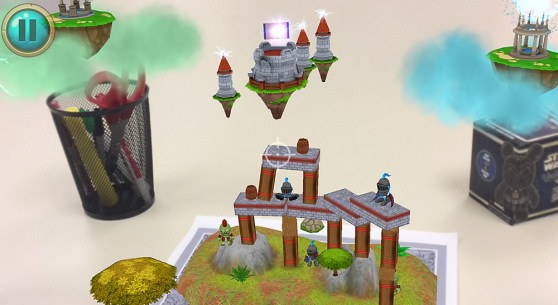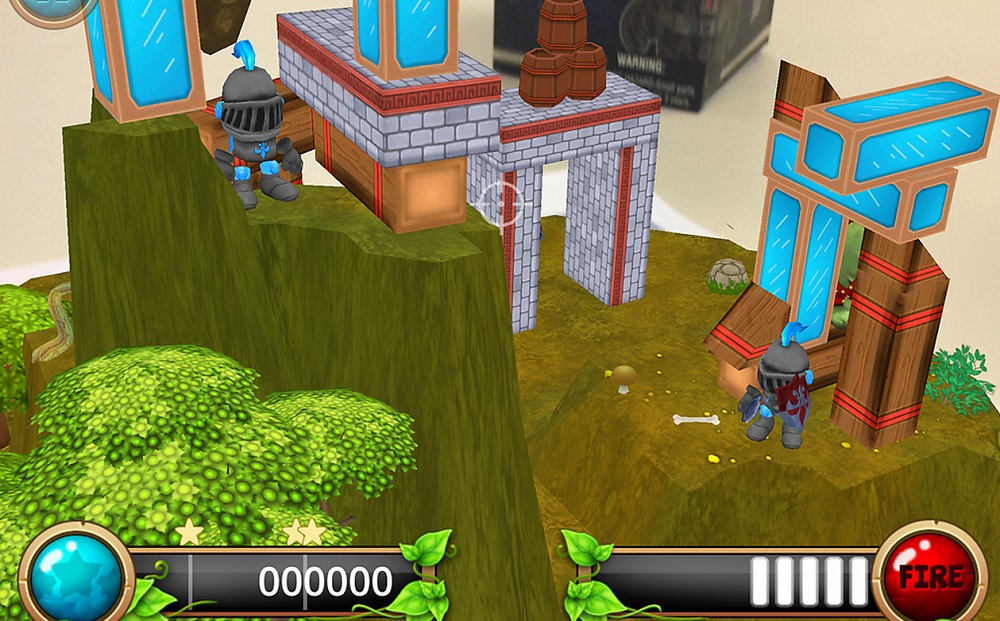UIEvolution, a 13-year-old tech company, is trying its hand at augmented reality with the release of a mobile game called Shatter Isle.
The game users computer vision to weave the virtual and real world together in a seamless way, and the aim is to take the technology of augmented reality entertainment past the first generation of pop-up book visual effects.
It is launching on both iOS and Android mobile devices today. To play, gamers knock down elaborate 3D structures that are blended on screen with everyday objects on their desks. Those everyday objects in the real world become part of the play field in the game. Players battle rogue knights and ogres in an immersive combination of the home and a colorful world of floating islands.
Dylan Malone, development lead and game designer at UIEvolution, said in an email, “This is the first gaming usage of new object recognition capabilities allowing tabletop items to occlude and interact with the game objects behind them.
You have to destroy the bad guys before they can damage you. After placing a few household items on a table, players scan the area in a few seconds using a smartphone. Shatter Isle can recognize real world things like a can of soup, a stack of books, or almost anything else between the size of a deck of cards and a box of cereal. After that setup, players can bounce shots off the cereal box or watch a fireball roll off the edge of a kitchen table and hit the floor.
The game adds some intensity as the players must physically dodge incoming fire from the wizard’s tower. If you’re hit, the shots will “crack” the screen. The game has novel play mechanics that are targeted at casual gamers. On iOS, the recommended hardware is a retina-based iPad or newer, or an iPhone 4S or newer. Android devices should have a multicore processor, a rear-facing camera, and Android 4.1.x or better.
“During development, the first time we bounced a giant fireball off a box of tea and watched it realistically collide, leave behind a burn mark, and roll convincingly away, we knew we had something truly new to bring gamers,” said Malone.

Making games isn’t the main task at UIEvolution, which makes software and services for connected products and automobiles. Asked if this was a kind of side project, Malone said, “That’s a fair characterization, but a strategically chosen side project. We see computer vision as a major area for innovation in the coming years, and so we keep a small team working at the cutting edge, and have recently started releasing some clever entertainment products (this will be our second commercial release from that group).”
He added, “We build these as we explore the technology for more conventional enterprise applications such as hospitality, automotive, etc. sectors where our major focus has been.”
The game uses Qualcomm’s Vuforia computer vision systems to recognize arbitrary 3D objects. Malone said that augmented reality games have been underwhelming so far, but the technology is on the verge of mainstream appeal.
“Computer vision has incredible but thus far almost completely untapped potential for entertainment,” said Malone. “A convincing physics game is well suited to AR space, where the line between the real and the fantastic will grow blurry over the next few years.”
[youtube=http://www.youtube.com/watch?v=VXUNcSZOq7g&w=560&h=315]


